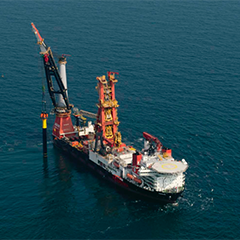In the search for alternative ways to make foundation installations quieter, faster and easier, the offshore vibro driving technology has developed in leaps and bounds over the past 20 years. The ever-increasing demand for reducing the Levelised Cost of Energy (LCOE) and protecting the underwater wildlife, has triggered out of the box thinking for the foundation pile installation.
The origin of vibro driving on land goes back to the 1930’s. It became more common offshore about 20 years ago, when onshore vibro hammers were used to install relatively small piles. Since then the largest land vibro hammers have been used occasionally, sometimes combining several of them for larger diameters or when more power was required. The current record is ‘piles’ with a diameter of 30 metres, driven with a multiple linked vibro in China!
After entering the offshore market with vibro hammers back in 2008, CAPE Holland developed a multiple vibro for the first ever monopile for a WTG in 2012. In the German exclusive zone, the monopiles for the Riffgat Offshore Wind Farm were driven to a stable depth, without noise mitigation before they were driven to their final depth with an impact hammer, due to the strict German regulations. The same regulations also required noise mitigation for this last stage of the driving process.



























